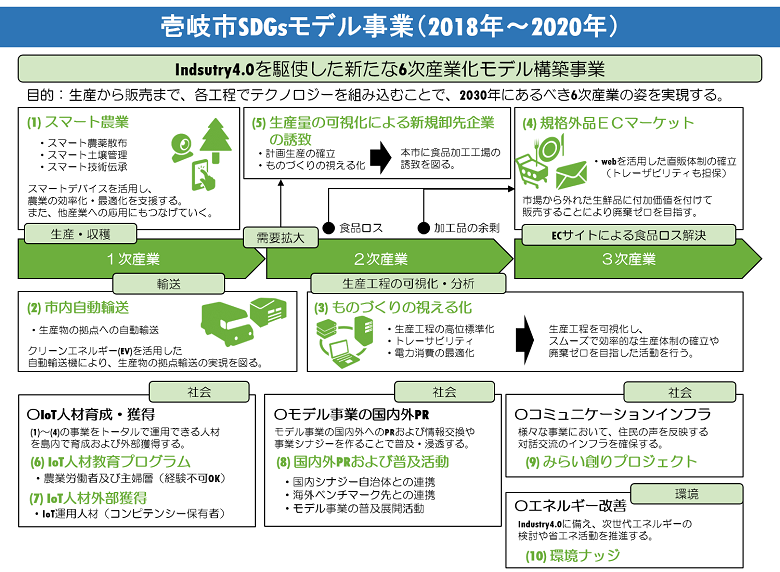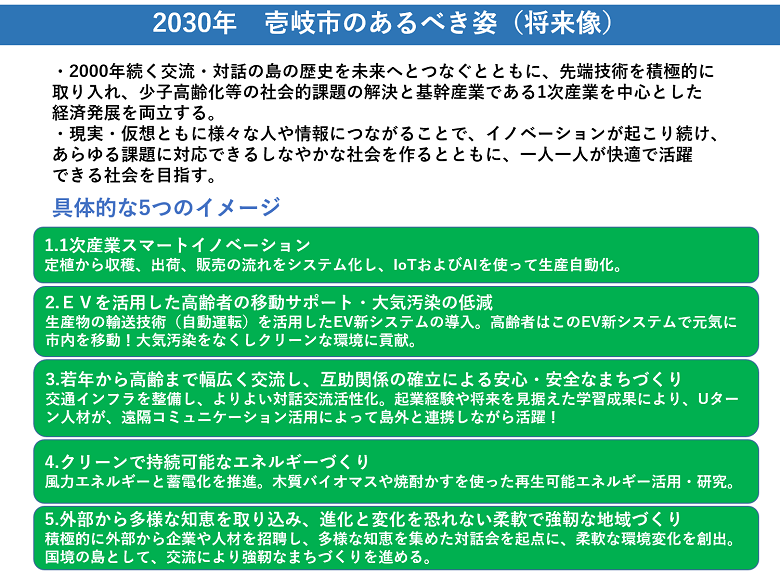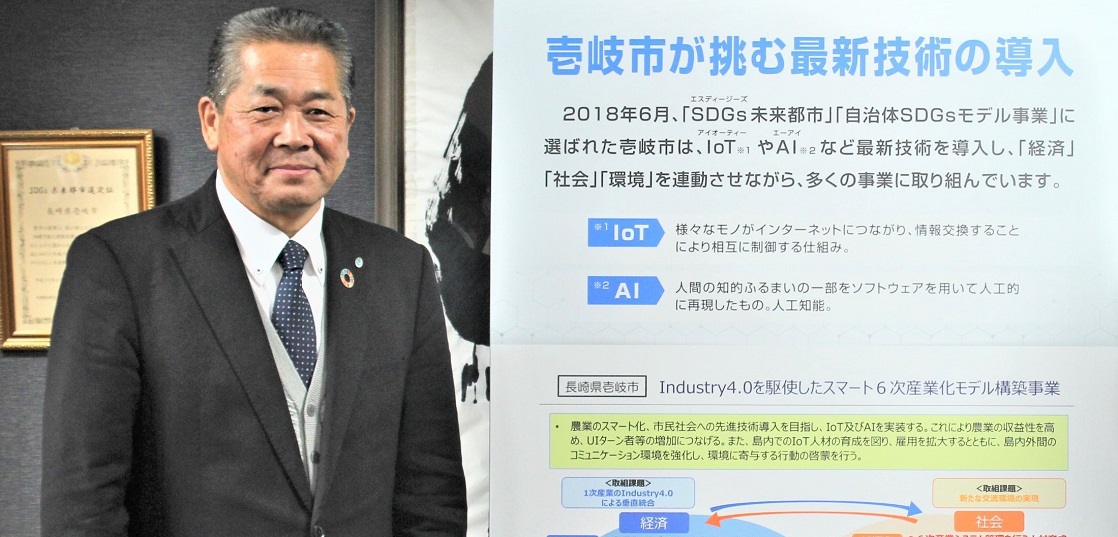In September 2019, Iki City, Nagasaki Prefecture was the first Japanese municipality to declare a "Climate Emergency Declaration."
Why did Iki City, a remote island in Nagasaki Prefecture, declare the "Climate Emergency Declaration" earliest in the local government? And what kind of island future do you want to create as a local government together with private companies? We interviewed Deputy Mayor Yoaki Manabe about the background and efforts.
Why Declared a "Climate Emergency Declaration"
— Declared a "Climate Emergency Declaration". What was the background?
Yoko Manabe (hereinafter referred to as Manabe): In recent years, Climate Change caused by human activities has become apparent. Climate Change is having devastating impacts around the world, including wildfires, floods, rising sea levels, and droughts.
Iki is no exception to these influences. For example, in Iki City, the scale of typhoons has become larger than before, and due to the change in course, heavy rains and floods that cannot be dealt with by conventional flood control facilities are increasing. Iki is a remote island with a thriving primary industry. The impact on the yield of agricultural products and marine products is spreading.
In order to curb Climate Change that causes these effects, Iki City has been implementing various initiatives under the comprehensive plan since 2015 to promote the creation of a low-carbon island. And in 2018, SDGs future city※With the tailwind of being selected as, we would like to further accelerate our efforts for low carbonization. This Climate Emergency Declaration is an extension of the efforts of Iki City so far, and is positioned as a declaration to promote further efforts in the future.
* SDGs Future City: Achieve sustainable development through the creation of new value in the three aspects of economy, society, and environment, from among cities and regions that are trying to promote basic and comprehensive efforts in line with the SDGs philosophy. Those selected by the government as cities / regions with high potential to do so.
— I heard that this is the first declaration for a local government in Japan.
Manabe: Since 2016, 901 local governments in 18 countries have already declared a "climate emergency" (as of the end of July 2019). In addition, not only local governments, but also universities, various organizations, academic societies, etc. have declared it, and it is not uncommon in terms of global standards. In Japan, awareness and support are gradually spreading, such as the Environmental Management Association issuing a statement in August 2019. There are limits to what individual local governments can do when it comes to Climate Change countermeasures. In the future, I hope that the declaration will spread among various organizations, including local governments.
Conducting environmental activities with the cooperation of citizens
— Please tell us about the initiatives you have been working on so far.
Manabe: So far, we have been working on energy saving and 4R (Refuse, Reduce, Reuse, Recycle) activities. Regarding energy conservation, we have formulated the "Iki City Global Warming Countermeasures Implementation Plan" and are working together with the city hall to reduce energy consumption in 2020 by 6% compared to 2014. In 4R activities, we have already achieved a recycling rate of about 36% (1st in Nagasaki Prefecture), and we plan to increase this rate to 40% or more in 2027. We also collect used clothing and shochu bottles, reduce the amount of plastic shopping bags and kitchen waste, and encourage composting.
Citizens' cooperation is essential for these efforts, and we encourage awareness and behavioral changes through environmental education and behavioral economics methods. For example, we are implementing an initiative to have each citizen write their name on the garbage bag when disposing of the garbage so that each citizen has a sense of ownership. We believe that each of these initiatives will be the key to curbing Climate Change.

—Are there any issues you feel in your efforts?
Manabe: Iki city is a remote island, so it is surrounded by the sea. Therefore, I would like to thoroughly engage in 4R activities, especially for plastic waste that causes marine pollution. In addition, the renewable energy introduction rate is currently around 9%, so we would like to increase this ratio. Specifically, we are aiming for a renewable energy introduction rate of 24% in 2030 and 100% by 2050. In addition to wind power and solar power generation, we have also started research on power generation using hydrogen with private companies.
— We are actively working on low-carbon power generation, but what about low-carbon fuels?
Manabe: Like other remote islands, Iki City has limited public transportation, so the usage rate of private cars is very high. We would like to promote the introduction of electric vehicles and fuel cell vehicles, but the maintenance of charging stations and hydrogen stations requires a large amount of money.
In addition, Iki has a thriving fishing industry, so many fishing boats are owned by those involved in the fishing industry, but no means for reducing the carbon content of the fuel used in this fishing boat has been found.
— One of the characteristics of biofuels is that the existing supply infrastructure can be used as is. How would you rate this as a means of reducing carbon?
Manabe: From a financial point of view, it is attractive that there is no initial cost for infrastructure development. In addition, by using the existing infrastructure, businesses that are currently engaged in fuel supply can engage in business as they are, which also reduces the burden on businesses and makes it easier to spread.
Accelerate efforts toward the ideal 2030
— Please tell us about the environmental business you would like to work on in the future.
Manabe: Iki City has set the ideal image of Iki City in 2030. Specifically, I have the following five images.
① Smart innovation in the primary industry
(2) Mobility support for the elderly and reduction of air pollution using electric transportation equipment
③ Creating a safe and secure town by interacting widely from young people to the elderly and establishing mutual aid relationships
④ Creating clean and sustainable energy
⑤ Incorporate diverse wisdom from the outside to create a flexible and strong community that is not afraid of evolution and change
Utilizing new technologies, human resources, and wisdom, we aim to develop industries, transportation infrastructure, and human resources centered on primary industries, and at the same time, promote energy conservation, renewable energy, and 4R activities to achieve sustainable development. We aim to realize a recycling-oriented community.
The industry in Iki City is centered on primary industries such as fisheries, agriculture, and livestock. Efforts to combat global warming and curb Climate Change are essential efforts for industry, and we would like to continue working with the entire local community.

Our role do you expect a venture company like Euglena to play?
Manabe: I think that there is a limit to the achievement of Iki City's goals by the businesses on the island alone. As the five images of Iki City aiming for 2030, we recognize the need to incorporate advanced technology from outside the island. Our will also expand into Iki and propose various initiatives to achieve the SDGs by utilizing advanced technology.
-thank you. Euglena is also a shareholder of Oriental Air Bridge, a regional airline that connects Nagasaki Prefecture's remote islands (Iki, Goto, Tsushima) and Nagasaki Airport. I think it's sad that tourists come to Iki while emitting CO₂ to experience the beautiful nature of remote islands. By all means, I would like to cooperate with advanced local governments such as Iki City in various ways and work to solve Climate Change.
Thank you very much for your valuable time today.
Manabe:I'm the one who should be thanking you.
About Iki, Nagasaki
It is an island facing the Genkai Sea at the midpoint between Fukuoka Prefecture and Tsushima City, Nagasaki Prefecture, and consists of the main island of Iki and 23 islands. It also appeared in "Wei Shi Yajinden" and "Nihon Shoki", and has been a key point of maritime transportation for many years since the Yayoi period. Currently, primary industries such as fishing and agriculture are thriving, and environmental industries that take advantage of the beauty of nature are also thriving. About 1 hour by high-speed boat from Hakata Port, about 30 minutes from Nagasaki Airport to Iki Airport.

